

Si hacemos caso a las leyes de la física, ¿cuál es el tamaño máximo que podría tener un animal en la Tierra? Cuando vemos películas como Godzilla o King Kong sabemos que esas criaturas son totalmente irreales.
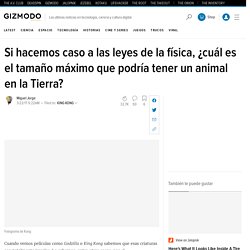
Lo sabemos, entre otras cosas, por el desproporcionado tamaño que tienen. Pero si los observamos desde el prisma de la física, ¿qué tamaño máximo podría llegar a tener un animal en la Tierra? No sólo King Kong, en el mundo del cine tenemos muchos ejemplos, sin ir más lejos la reciente Kong: Skull Island. Todos estos films nos suelen mostrar un mismo espacio solitario, generalmente una isla, donde unos exploradores/científicos acuden y se encuentran con criaturas gigantescas que pesan toneladas. Si bien la gran mayoría de estas películas no trata de ser realistas ni de tener una precisión científica, el hombre sí podría cuestionarse la altura máxima que podría alcanzar una criatura. Eso es precisamente lo que ha hecho el paleobiólogo de la Universidad de Stanford, Jonathan Payne.
Payne pone un ejemplo muy gráfico que todos podemos entender: las arañas. El elefante como el animal más grande. The Second Industrial Divide on JSTOR. Reviews in American History Description: Reviews in American History provides an effective means for scholars and students of American history to stay up to date in their discipline.

Each issue presents in-depth reviews of over thirty of the newest books in American history—reviews that are far superior to those found in other scholarly journals. Retrospective essays examining landmark works by major historians are also regularly featured. The journal covers all areas of American history including economics, military history, women in history, law, political history and philosophy, religion, social history, intellectual history, and cultural history. Coverage: 1973-2014 (Vol. 1, No. 1 - Vol. 42, No. 4) Moving Wall: 5 years (What is the moving wall?)
The "moving wall" represents the time period between the last issue available in JSTOR and the most recently published issue of a journal. Terms Related to the Moving Wall Fixed walls: Journals with no new volumes being added to the archive. Manuel DeLanda: Teoría de los ensamblajes y complejidad social..pdf. Speaker Impedance Explained - Ohms. Meditations on Speaker Impedance ("OHMmmmmmmmm") One source of confusion we frequently run across is the concept of speaker impedance.

This confusion is also a likely cause of many blown power amplifiers. This article is intended to explain the meaning of speaker impedance and guide the reader in connecting multiple speakers to an amplifier. Warehouse Arts Management Organization. National Endowment for the Arts. Creative Placemaking Resources. Global Forum on the Culture of Innovation. In partnership, the Urban Land Institute and the Aspen Institute present the Global Forum on the Culture of Innovation.
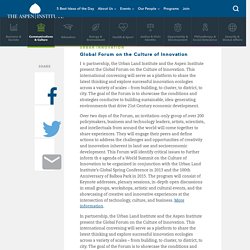
This international convening will serve as a platform to share the latest thinking and explore successful innovation ecologies across a variety of scales – from building, to cluster, to district, to city. The goal of the Forum is to showcase the conditions and strategies conducive to building sustainable, idea-generating environments that drive 21st Century economic development. Over two days of the Forum, an invitation-only group of over 200 policymakers, business and technology leaders, artists, scientists, and intellectuals from around the world will come together to share experiences. They will engage their peers and define actions to address the challenges and opportunities of creativity and innovation inherent in land use and socioeconomic development. Event information Date. The Ecology of Innovation. The recently announced seminar of the Urban Land Institute, in partnership with the prestigious Aspen Institute, champions the idea there is a new “innovation ecology,” a term first coined by computer science guru William A.

Wulf, shaping our landscape — an ecology that influences land use and spells economic development. The Ecology of Innovation: Part 1 – Ideas. Innovation Ecology There is a tendency when looking at innovation to focus on the end result of a process of creation rather than as one node in a larger body of activity, yet expanding our frame of reference to see these connections innovation starts to look look much more like an ecosystem than a simple outcome.
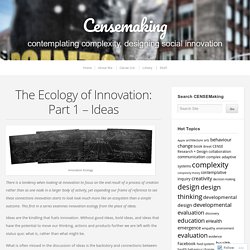
This first in a series examines innovation ecology from the place of ideas. Ideas are the kindling that fuels innovation. Without good ideas, bold ideas, and ideas that have the potential to move our thinking, actions and products further we are left with the status quo: what is, rather than what might be. What is often missed in the discussion of ideas is the backstory and connections between thoughts that lead to the ideas that may eventually lead to something that becomes an innovation*. Drawing Connections. Biophilia: el revolucionario proyecto educativo creado por Björk - Cultura Inquieta. La creatividad, la música, las ciencias naturales y la tecnología se combinan en un proyecto educativo innovador, sensible y relevante.
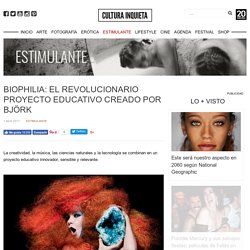
La educación es, sin duda alguna, una de las esperanzas más tangibles para la humanidad. Es quizá dentro de este ámbito donde es posible generar una transformación global, profunda y verdadera. Por esta razón, los proyectos educativos más innovadores y conscientes —aquellos que pretenden solucionar nuestras carencias profundas como especie— son grandes tesoros, dignos de mayor atención, cuidado y divulgación. Flocking and Rendezvous in Distributed Robotics - Bruce A. Francis, Manfredi Maggiore. Prototypes in Design: Materializing Futures. Issue Number Zero: Prototyping Prototyping Alex Wilkie The two excerpts that follow are drawn from my Ph.D. research User Assemblages in Design: An Ethnographic Study.
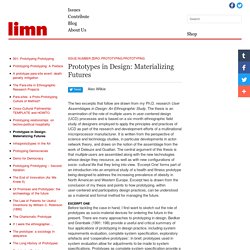
The thesis is an examination of the role of multiple users in user-centered design (UCD) processes and is based on a six-month ethnographic field study of designers employed to apply the principles and practices of UCD as part of the research and development efforts of a multinational microprocessor manufacturer. It is written from the perspective of science and technology studies, in particular developments in actor-network theory, and draws on the notion of the assemblage from the work of Deleuze and Guattari.
The central argument of this thesis is that multiple users are assembled along with the new technologies whose design they resource, as well as with new configurations of socio- cultural life that they bring into view. Prototyping as research method 1 1. A Comparison of Deleuze’s Assemblage Theory and the New Materialist Approach.